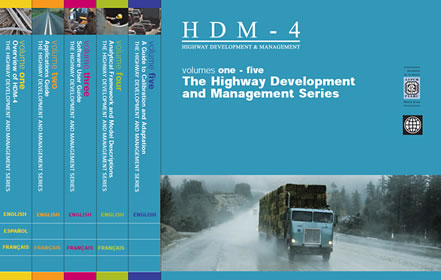Highway Design and Maintenance
Harmonised systems approach to road management
Harmonised systems approach to road management

The Highway Design and Maintenance Standards Model (HDM-III), developed by the World Bank, has been used for over two decades to combine technical and economic appraisal of road investment projects, standards and strategies. The International Study of Highway Development and Management (ISOHDM) have extended the scope of the HDM-III model to provide a harmonized systems approach to road management, with adaptable and user-friendly software tools. The new Highway Development and Management (HDM-4) system is the result of the study.
Provides a powerful system for:
There are four main areas of application:
Used to prepare medium to long term planning estimates of funding needs for road network development and maintenance. Estimates of the medium to long term budget requirements for the entire road network together with forecasts of pavement performance and road user effects can be obtained. The impact of different Budget Scenarios can be estimates together with the Asset Value of the network.
Used to prepare rolling work programmes in which candidate road sections are identified and assigned maintenance or improvement options. HDM-4 calculates the economic benefits and expenditure requirements of each option. A schedule of optimum pavement maintenance and/or road improvement projects which can be carried out within specified budget constraints are identified.
Project analysis can be used to estimate the economic or engineering viability of road investment projects by performing life cycle analysis of pavement performance, maintenance and/or improvement effects together with estimates of road user costs. The main outputs include:
Sensitivity Analysis allows a user to investigate the impact of variations in key parameters on the analysis results.
Multi-Criteria analysis (MCA) provides a means of comparing projects using criteria that cannot easily be assigned an economic cost. For example, environmental, social or political impacts.
HDM-4 can be used to conduct a number of road sector policy studies including:
Default data and calibration coefficients can be user defined for any country or region. This allows HDM-4 to be configured to suit the customers’ local conditions and therefore can be applied throughout the world.
By exchanging data with a Pavement Management System (PMS) or other database HDM-4 can utilize existing data to perform an analysis. The output reports can be adapted to individual requirements thereby integrating HDM-4 into an existing road management framework.
HDM-Sentry operates as a data-preparation tool for HDM-4 which takes user-defined analysis data via easy-to-navigate data entry screens, converts into an HDM-4 compatible analysis file-set and sends the data to HDM-4 where the analysis is performed. HDM-Sentry aggregates the results and presents them as HDM-4 analysis reports.
Windows 98/NT/2000/XP/VISTA/Windows 7/8/10

Stay up to date with news from TRL Software